But at the heart of it all, this is a Japanese horror film. Made in 1960, most horror films at the time played directly to the Japanese psyche: slow, suspenseful, where you know there's something terrifying juuuust beyond the shoji screen, but not knowing what it is makes it all the more frightening. These films, precursors to modern international hits like Ringu, Ju-On, Dark Water and the like, are still remembered and often viewed today by fans of the Asian horror genre; films like Onibaba, Kwaidan and Ugetsu Monogatari can still be found on movie channels and DVD racks the world over.
This film, Jigoku, is not so well remembered. While the director, Nakagawa Nobuo, became very popular at the time of his career, his movies were not the subtly scary yōkai-tinged thrillers of most of his contemporaries. Even though only a few of his many films were in the horror or ghost story genre, the ones he did make are remembered to this day for their excellent visuals and direction. Like all good directors, Nakagawa was very eccentric, and his remembered well for his bizarre behaviour and penchant for wearing geta at all times, even on set. Despite often being referred to as "the Alfred Hitchcock of Japan" (and this film itself drawing inspiration from a murder case also depicted on the screen by Hitchcock), the suspense he masterfully built up in many of his earlier mystery films did not get the recognition that they may have gotten under different circumstances.
The circumstances? Shintoho, the film studio he worked for. After World War II, members of the Toho Production Company unveiled Shintoho (New Toho) Studios, and audiences were made aware very quickly of just the sort of films they were interested in making. You can't deny that Nakagawa's films had a certain cool quality about them...
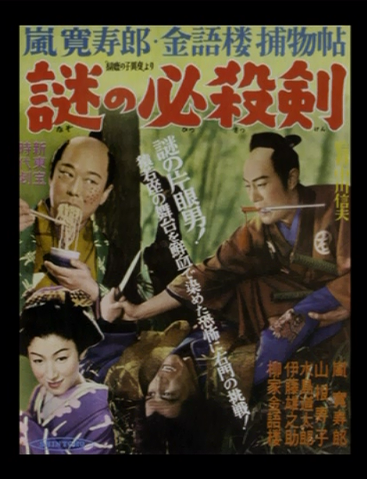
Nazo no Hissatsu-ken (The Mysterious Blade)
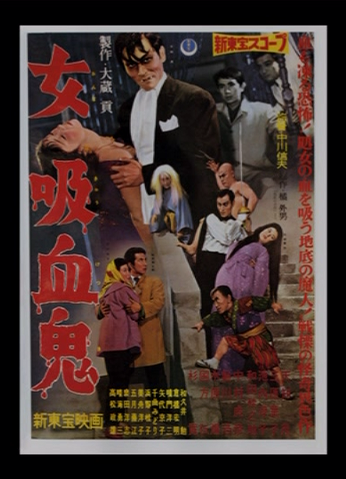
Onna Kyuketsuki (The Vampire Lady)

Kenpei to Yuurei (The Military Policeman and the Ghost)
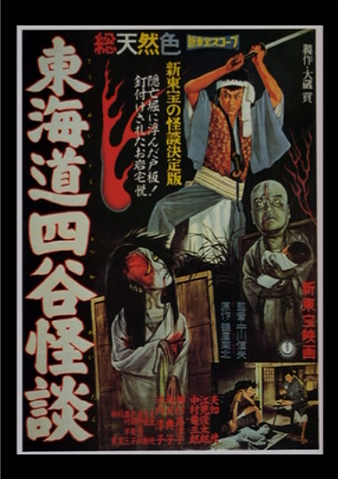
Tokaido Yotsuya Kaidan (Yotsuya Ghost Story), another of his phenomenal works, based off of the popular tale.
While the movies may appear slightly cheesy, Nakagawa really did an amazing job with the work he was given, which was pretty impressive since the majority of Shintoho's movies looked more like this...
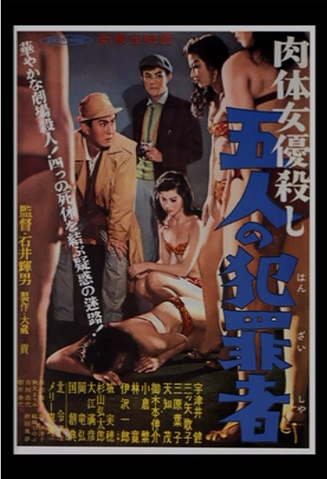
Nikutai Joyu Goroshi - Gonin no Hanzaisha (Nude Actress Murder - Five Criminals)
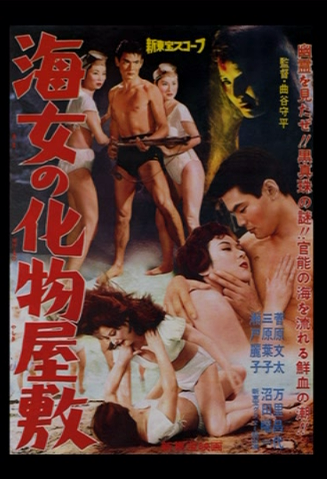
Ama no Bakemono Yashiki (Girl Divers In A Haunted House)
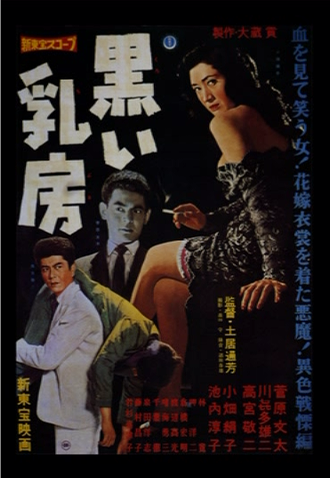
Kuroi Chibusa (Dark Breasts)

And who could forget the Sexy Line? (Sexy Chitai)
Needless to say, when Jigoku (and even Tokaido Yotsuya Kaidan before it) came out, many people dismissed it as just another one of those low-budget Shintoho films, which all seemed to be soft-core exploitation or really cheap and gory horror films churned out for summer in attempt to cash on on horror film season.
It didn't help matters that Jigoku came out in 1961, touting a film heavily influenced by Western visuals, something nobody had really seen before in a horror film and therefore should be wary of, and that it had almost zero budget, ending up as the very last film eked out of Shintoho before they declared bankruptcy and folded.
Jigoku was really far ahead of its time, and it deserves recognition for the absolutely stunning visuals and message presented in it, not to mention basically founding the ero-guro genre that is so popular today (even at Shintoho, blood on film was generally kept to a minimum, if at all). It is also gaining further notoriety for being one of, if not the first film to capitalize on Western plot devices, sensibilities, and the manner in which horrific imagery is approached, and to actually depict Buddhist Hell. It has since been remade several times, but finally Nakagawa Nobuo is getting the recognition that he deserves as one of the iconic directors of Japan (especially in this groundbreaking film that he still managed with no budget and the company against the amount of blood and gore). This movie is amazing and still must be seen to be believed. Please check it out if you can, and enjoy the review!
Movie Review - 地獄 - Jigoku
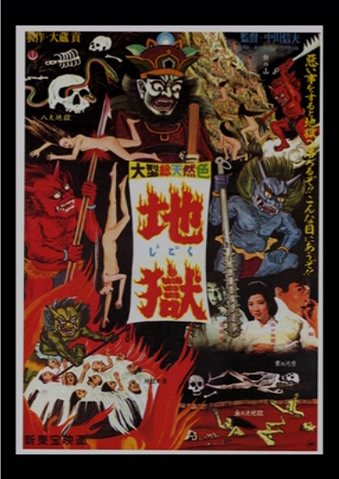
The film opens in a pretty startling way, a woman operatically singing a line reminiscent of the Atsumori ("a human life is nothing but a short time under heaven") overlaid with a casket being prepared for cremation. The screen erupts in flames and we see the title of the film. The credits begin to roll as we are assaulted with a barrage of differing sounds, bebop jazz music, a baby crying, a woman moaning, a director shouting "action!" and finally just all-out screaming and police sirens while women perform a nude striptease around the title cards. This has absolutely nothing to do with the film and I love it. It's almost as if Nakagawa is saying "Yes, that's right, it's just another one of those bad Shintoho films, now get nice and relaxed while I blow your mind."
Suddenly it all drops out and the summary of the film is given in disturbing voice-over, drowned corpses shown as it is explained that man is only bumbling his way towards death, sinning without receiving punishment from the law. While they may escape judgement on Earth, no-one can escape his conscience, and that belief denotes the judgement of Hell after death. The operatic singer returns and echoes the sentiment, that this tale is one of what happens after death, the supernatural and tortuous depths of Hell. We witness a young man standing at the shores of the river to Hell, before he is cast screaming into the fiery pit.
The next scene is in a university classroom, where a teacher lectures the students of the concept of Hell in Buddhism and many other religions that often bear a defined resemblance to one another. A young man near the back of the classroom, identified as the same young man we saw at the Sanzu River moments before, stares lazily into the distance during the lecture. Suddenly, a man appears next to him out of nowhere. At first. the young man is startled, but accepts the occurrence as nothing out of the ordinary, and his friend goes on to tell him that "the man from last night" is dead. This upsets our jumpy antagonist Shiro, while Tamura seems to feel completely bored with the whole thing and changes the subject to congratulate Shiro on his recent engagement to Yukiko, the Professor's daughter. Professor Yajima, meanwhile, is still lecturing on Hell, now explaining about Hachi Dai-Jigoku, the Eight Great Hells from Buddhism. Tamura conspiratorially whispers to Shiro that the Professor is always viewed as such a great man, but in fact, Tamura heard of a sin he committed during the war that would explain the desperate attempt to always be so kind and good to everyone. Shiro grows uncomfortable and wonders to himself why Tamura is so terrible and won't just leave him alone. He wonders how he can escape Tamura's clutches and reminisces to the night before.
In an idyllic moment, Shiro and Yukiko share a passionate kiss before her extremely traditional picture-perfect parents saunter in and congratulate the pair on their joyous engagement. They urge Shiro to take good care of Yukiko, their only daughter, and to work hard in school to become a professor like her father. Suddenly, Tamura appears out of nowhere and offers a sarcastic congratulation as well. He really is just great, such a nice guy with no ulterior motives at all.

Horror fans may recognize the actor Numata Yoichi as the same one who plays Sadako's father in the iconic Ring series, a part he was specifically asked to play because they enjoyed him so much in Jigoku.

Interestingly, Mr. Numata stated at the time that he had no idea why his character of Tamura was so insanely creepy throughout the film, and just played him in a bizarre way in order to get Director Nakagawa to correct and explain the point of Tamura's actions to him and give him guidance. Nakagawa never interrupted the outlandishly sinister performance Numata put on, and therefore Tamura throughout the film is this Joker-esque study of unhinged insanity. He's extremely fun to watch.
He goes on to say that he would have called ahead first, but was so upset at being thrown out on his previous visit that he decided to make his way in on his own. He explains to the Professor that he came to return a book, and hands it to the man, opening it to a picture he's inserted showing photographic evidence of the Professor during the war stealing water from a dying comrade. He then tells Mrs. Yajima that her clock has stopped, which is a very bad omen, thereby cursing Shiro and Yukiko's wedding. He then takes his leave. Absolutely brilliant.
In the car on the way home, Tamura throws some money at Shiro and tells him how much he likes him, and that he knows all of his dark secrets, including the fact that he's been having premarital relations with Yukiko. He goes on to say that she's probably pregnant, and that is the cause for the engagement. Shiro, once again used to all of this behaviour, ignores him and asks him to go down a different road so that he can make a stop somewhere. We never find out just what this stop was, however, as a drunken yakuza stumbles into the street and gets mowed down by Tamura's car.
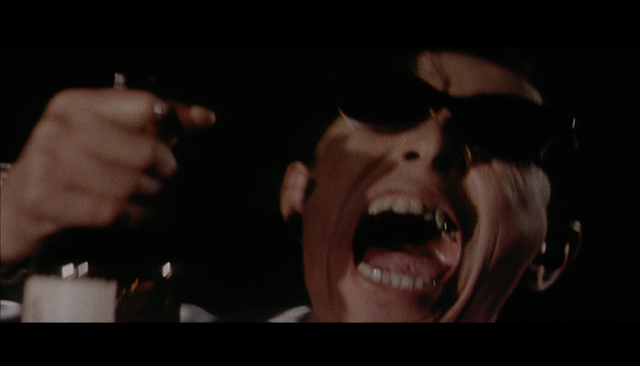
Tamura, being the upstanding young man he is, performs a hit-and-run as the yakuza dies, but not before the man's mother rushes to his side in time to get the license plate number.
Shiro begs Tamura to stop the car to help, but Tamura drives on, saying that it was the yakuza's fault for jumping out in the road, and it's not his problem. Shiro continues to protest, but Tamura shuts him up by stating that it was Shiro's idea to take the road, and his fault more than Tamura's. Racked with guilt at the idea of being a murderer, Shiro's reverie is interrupted by Professor Yajima, and the rest of the class has left. He invites Shiro over to visit Yukiko that evening, while Tamura slowly files out of the classroom in an ominous way.
Elsewhere, the yakuza Tiger Kyoichi's mother and extremely 1960s-looking girlfriend

tell the rest of his gang that they have no idea who hit him. Tamura reads a news report of his death to Shiro, who once again begs him to come to the police with him and admit to the incident. Tamura says he has no interest in that sort of thing, and that the yakuza in fact deserved to die, certainly not worth going to prison for. Shiro leaves, but Tamura tells him that Shiro owes him, and if Shiro turns Tamura in he'll bring Shiro down with him.
Only Tiger Kyoichi's mother and girlfriend are left at his funeral, though they did choose an excellent portrait of him.

His mother wonders what they will do for money now, while his girlfriend Yoko wishes she could avenge his death. Kyoichi's mother admits that she did see the car, but didn't tell the police, since years before when her husband was ran over by a truck, the police didn't even send the driver to jail. She and Yoko vow to kill the person who killed Kyoichi.
When Shiro arrives at Yukiko's, she is overjoyed to see him, having waited all day to show him a new pink parasol and tell him some good news. The news has to wait, though, when she sees Shiro standing in the corner clutching the newspaper article about Kyoichi's death, and says he must confess something to her. While Shiro really is just so annoying in his constant pure-and-innocent plight, the actor who plays him, Amachi Shigeru, was not used to playing such a part at all. When the famous Shintoho star meant to play Shiro was unable to do it, Amachi was cast at the last minute and challenged by Nakagawa to play this role, having become somewhat famous for hard-boiled detective types on TV, or sadistic men in other films.
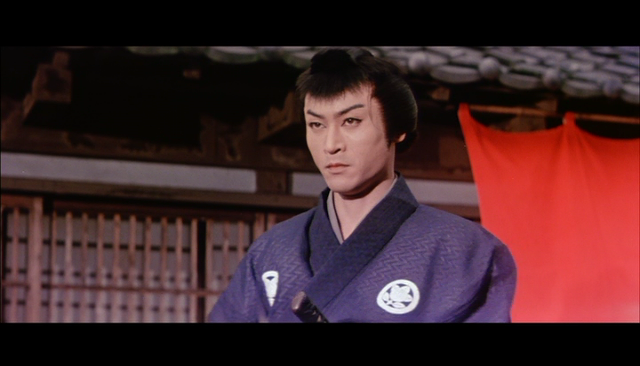
Here is Amachi looking badass as hell playing Iemon in Nakagawa's Tokaido Yotsuya Kaidan.
Shiro asks Yukiko to accompany him to the police, and when she asks him to talk to her father first to get it all straightened out, Shiro begins to grow upset and frantically looks down the road for a taxi. Yukiko suddenly gets a bad feeling and promises to come with him if they can walk to the police station instead. Shiro insists that they must get a taxi to get there as quickly as possible since he can feel something "chasing him" to get it off his chest right away, and when Yukiko begs him to walk instead, he calls her a child.
A taxi arrives and he pushes Yukiko inside, and she asks the driver to make sure to go slowly and carefully. for a second, the cabbie becomes Tamura, and the taxi loses control and crashes into a tree. Yukiko's pink parasol flies from the cab and she goes through the window and dies. At her funeral, Shiro confesses that he made her take a taxi and that he feels solely responsible for her death. Yukiko's mother is inconsolable and wants Shiro to leave before begging him to return her daughter.
Shiro goes to a strip club, where he hears Tamura's voice blaming him for Yukiko's death as a result of his attempt to turn Tamura in. He becomes agitated before being calmed by a female patron, who turns out to be Yoko. She propositions him and he refuses, but she chases after him and they end up going to a hotel. Yoko does drugs and rifles through Shiro's coat, finding his ID and realizing that he is the one who killed Kyoichi. She arranges to meet with Shiro the next night, and conspires with Kyoichi's mother to kill him that evening, but Shiro doesn't show.
Shiro's father had sent him a telegram saying that his mother is in critical condition and he must come home right away. He takes the train to the countryside town of Tenjoen, where his father manages a rest home. All of the inhabitants of this town seem to be batshit crazy. A slutty looking woman leads him to his mother, who is on her deathbed. She is happy to see Shiro, but then begins to cry. In the next room, the noises of Shiro's father and the trampy girl Kinuko can easily be heard. Shiro's mother blames her condition as the cause of it, and Shiro understands the situation. He is distracted from this, however, as he sees Yukiko outside spinning her pink parasol.
She cheerfully says hello to Shiro and introduces herself as Sachiko, who has been taking care of his mother and sent the telegram to him. Shiro's mother explains that Sachiko's father is a good friend of Shiro's father, a painter who has moved in next door. Shiro goes to visit and finds the man drinking heavily and painting like a madman.
All of his paintings are depictions of Hell, very similar to the Jigokuzoshi scroll which much of the art direction of this movie was influenced by. Shiro's father explains that he is having paintings of Hell done for the temple, and that Sachiko's father was a very good artist, but because of his drinking had to come and stay at the rest home. The local detective comes in to look at the work as well and offends Sachiko, but prods her father to let her marry him. Sachiko's father refuses, and the detective attempts to bribe him by threatening to expose his arrest warrant. The doctor comes in to look at the painting, and the detective insists that they will get the entire matter of his marriage to Sachiko sorted out once her father is finished with the temple paintings.
Meanwhile, an old man collapses and the doctor rushes to his aid. A patient tells him that everybody is getting sick because of the bad food, and accuses him of skimping on money. The doctor chastises him and says that the rest home is in debt as it is, and nothing is wrong with the food. The detective takes the opportunity to put some pressure on Sachiko, who runs off. Shiro gazes after her as the detective's insane sister or mother or someone teases him for having a crush on Sachiko and dances around laughing. Really, absolutely everyone here is mad.
A few days later, Shiro walks on the train tracks and steps out of the way just as a train goes by. Sachiko, who had been watching him, rushes over because she thought he was hit, but pleasantly thanks him for coming to see his mother, and how much better she looks now that he's here. They continue to chat, Sachiko mentions her dream to accompany his mother to Tokyo when she is well, and it sounds as if another train goes by, even though they are standing on the tracks. Shiro turns around and is treated to an unpleasant surprise.

Tamura tells Shiro he was just dropping in to see how he was, and comments on how much Sachiko looks like Yukiko. He informs him that Yukiko's parents are also arriving in Tenjoen on a lecture. Shiro shouts at Tamura to leave him alone, and Tamura explains that he plans to stay in town for a long time and heads to an inn. Kinuko rushes over and tells Shiro that his mother is on her deathbed again. She attempts to make out with Shiro and begs him to take her to Tokyo with him after his mother dies. Classy. Everybody wants to get the hell out of this town at all costs, but unfortunately it's a bit more literal than they hope. Shiro's mother dies, and Tamura waltzes in to announce the arrival of the Professor and his wife. Mrs. Yajima, still pretty insane, twirls around Yukiko's pink parasol at the table as Sachiko serves them tea. When she sees Sachiko, she mistakes her for her daughter and clutches her, crying in relief. Sachiko and Shiro stare off uncomfortably.
Later, the doctor is interviewed by the greatest journalist ever.
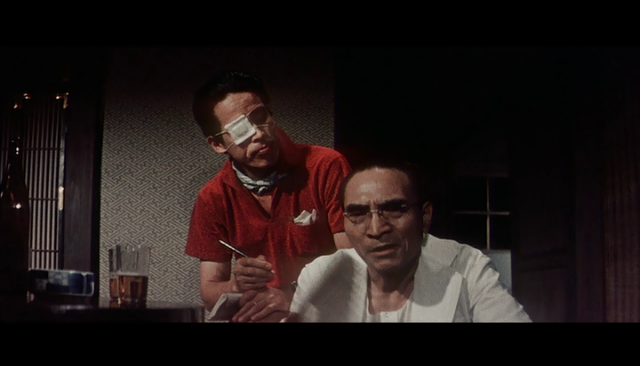
Seriously, look at that guy.
The doctor tells him that Shiro's mother passed away due to complications from her angina. Amidst the group of mourners, Tamura appears and strolls over to the doctor, informing the reporter that her death was caused by the doctor's malpractice. He and the reporter both seemed to think that the doctor's diagnoses was incorrect, but he hadn't bothered to actually make sure. Suddenly, Sachiko's father jumps up and accuses them all of being wrong, and that Shiro's father's affair within hearing distance of Shiro's mother was what killed her. He begins to rage that he was supposed to marry Shiro's mother, but Shiro's father stole her. Sachiko is forced to drag him from the room while Shiro's father curses at him and Kinuko giggles.
Tamura picks up the sword and begins swinging it around, giving a speech how everyone in the room was a murderer as well as the doctor. It seems that the detective framed a man on a bribe, which caused him to kill himself, the reporter wrote an incorrect article about someone who killed himself as a result as well, and Shiro's father was not only cheating on his wife, but on his mistress with another woman entirely. He turns on the Professor to remind him of his indiscretions during the war, but suddenly that man from earlier appears to inform everyone that the elderly patient is now dead. He blames them for his death, saying that they only care about the rest home's anniversary festival and can't be bothered over patients' health.
Of course, the anniversary festival arrives, and it really is a needlessly grand affair, with the Director and his skanky mistress are dressed in their gaudy finest.
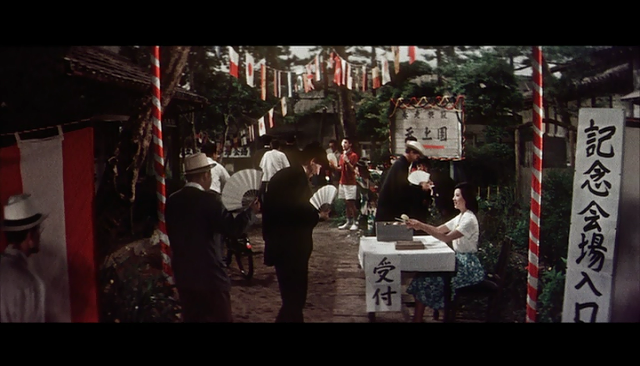
Meanwhile, the yakuza's mother and girlfriend have arrived in Tenjoen, and they wait along the river, where a fisherman gathers dead fish into his net. He delivers them to the rest home, where the doctor worries about the safety of the fish, but the Director assures him it should be fine since the fish are cheap and for the old people anyway. Shiro, despite knowing that Tamura has left town now, is unable to enjoy the party, since an article in the paper identifies the car responsible for the hit-and-run accident. Sachiko tells him that she has to go into town, but hopes Shiro will take her and her father hiking (seems like a bad idea). Shiro says that he must return to Tokyo with the Professor, but Kinuko interrupts and flirts with him, teasing him in front of Sachiko, who gets embarrassed and leaves. More women want a piece of Shiro, though, as Yoko sends him a letter to meet her, as she's come to town to see him.
In a stunningly shot scene, he meets her at the rope bridge, and she informs him that she knows everything about what he and Tamura did to her boyfriend, and pulls a gun on him. She admits that she was in love with him, but as she advances on him with the gun, she trips and falls into the gorge to her death. Shiro picks up the gun, but Tamura appears and tells Shiro that he should have listened, that Tamura is basically omnipotent, and will lead Shiro the way he needs to go. Shiro demands to know just who or what Tamura is, and points the gun at him. They battle over it and Shiro shoots Tamura in the scuffle, sending him over the side of the bridge to his death as well.
Things start moving at a breakneck pace now, as the old people thank the Director for their fish dinner. The rest of the staff, including the journalist and detective, celebrate with a meal provided by the tavern owner, Shiro's father's second mistress. First mistress Kinuko gets drunk and does a striptease and flirts with everyone, before running off to search for Shiro, whom she finds sobbing in the storehouse. The old people and the staff are both having a lot of fun at their respective parties. The Director finds Kinuko comforting Shiro, and flies into a drunken rage, swearing to kill them both. He chases Kinuko upstairs, and Shiro attemps to stop him, but in the fight, she falls down the stairs and dies. Shiro's father tells him to keep quiet about it. The Professor and his wife leave Shiro, as she carries the parasol around, shouting for her dead daughter.
Tiger Kyoichi's mother arrives to offer everyone more sake, and pours a generous portion for all. Everyone goes to take a drink, but Shiro is visited by a ghostly Tamura, who distracts him from drinking his glass. The group dies from the poisoned sake as Sachiko rushes in to tell Shiro that the Professor and his wife threw themselves in front of their train. Tamura pulls out a gun and shoots Sachiko. Tiger Kyoichi's mother, who had not drunk her share in order to watch Shiro first, rushes over and holds him on top of Tamura, strangling him. All of the old people die from the rotten fish (which was based on a true event). Once again, the clock stops at nine (the time it had stopped in the Yajima's home, the time Yoko had planned to meet Shiro, the time he had left and arrived in Tenjoen), and Shiro is sent into the fiery pits of Hell we witnessed at the beginning of the film.
And that is a Japanese horror story. The pace of most Japanese folk tales and supernatural stories is this way, a very long introduction of all of the characters, each sets himself up for downfall, and then suddenly that downfall or scary moment will be met, followed by a swift ending so that the listener is left alone with those thoughts of dread and what might happen. Onibaba is a good example of this, though it is seen in the more modern horror films as well. But as I said, this film really differentiates from that, and goes the Western route of now showing you just what happens after that moment. The difference so far was Tamura, whose character was based off of the Mephistopholes character from Faust, that dark and possibly supernatural character who leads you into the unknown. The true meaning of Tamura, however, is easily figured out if you think through it. Why couldn't Shiro escape Tamura? How did he keep showing up at any time, even after his apparent death? Nakagawa wanted this character to contrast as such an insane personality beside Shiro's pure intent, because he is in fact an allegory of Shiro's conscience, his inner self, and meant to throw you off since, in most depictions of this in film by this point, it would simply be played by the same actor. Nakagawa really wants you to think, to take these two sides and figure out what they mean, and what exactly Shiro's crime is that he must be sent to Hell.
But enough about that, it's time to dive headfirst into our Western-inspired depiction of Buddhist Hell, something never seen in Japanese film before.
Shiro must cross the River Sanzu, which means "three destinies". Depending on the extent of your sin, you must cross this river by safely crossing a bridge, heading a ford, or, for the worst cases, wading across the waters yourself. At the other side, you will be met and judged and sentenced to a part of Hell for torment depending on your crime. Sound familiar? While much of the approach to depicting Hell was in fact inspired by Dante's Inferno, the actual subject matter is purely Buddhist, much of it drawn from a text by the monk Genshin,Ōjōyōshū. It is famous for its very frank and disturbing explanation of Jigoku in Buddhism, which was written in the year 985, way before The Divine Comedy.
The scene is eerie and bizarre, flat colours and mist swirling around the still waters. Tamura appears and explains to Shiro that they must now go to Hell together. A baby screams in the distance, and Tamura tells Shiro that it is calling for him, and disappears.
Shiro is awaked with a spike through his neck, hanging inverted with blood dripping down his face. While this graphic and painful scene was nearly unheard of in a Japanese film, the colours and look of it is obviously drawn from the popularly graphic ukiyo-e, most notably the work of Yoshitoshi.

He is met by the Judge of Hell, Enma Dai-Oh, portrayed here in a cameo by the famous actor Arashi Kanjuro.
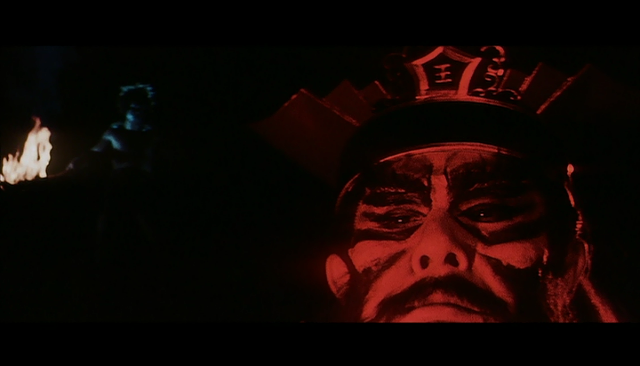
He introduces himself as the King of Hell and Lord of the Eight Hot Hells (Hachi Dai-Jigoku or Hachi Netsu Jigoku) and Eight Cold Hells (Hakkan Jigoku). Shiro is made to look into a mirror that reveals all of the people whose death he has caused. Enma Dai-Oh sentences Shiro to experience all of the Hells, which takes its cue from Inferno, for, though a sinner would only be sent to one specific place for torment depending on their crimes, like Dante, Shiro is "allowed" to witness all of the areas of Hell for the benefit of the audience.
Shiro awakens in a large plain filled with stones, which children appear to stack in prayer. This place, the Sai no Kawara, is the bank of the Sanzu River where children who die before their parents are sentenced. Also known as Limbo, because these children have gained no good karma in their short lives, as well as caused pain to the parents they have left behind, they are unable to cross the River or gain salvation from the place, so they must eternally pile stones on top of one another in prayer for salvation, while demons will appear and knock the piles down so that the children can never stop. Perhaps you've seen Jizo statues on the side of the road, in graveyards, or depicted somewhere? The stone statues are often dressed in red hats and bibs, children's clothes, or sometimes surrounded by toys or stacked stones. Jizo is a very popular deity, and parents will dress him this way because the red colour wards off evil things, and is hoped that he will protect their children with the clothes when he comes to the Limbo to shield them from the demons and eternal efforts of futility.
It is here that Shiro finds Yukiko.
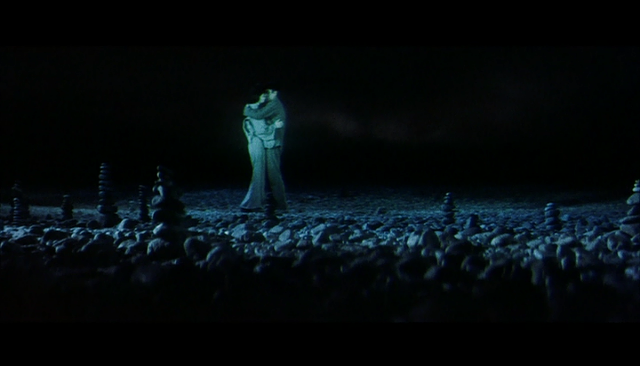
He apologizes to her, and they look around, hearing the baby crying again. Yukiko tells Shiro that it was their baby, and she meant to tell him that she was pregnant the night she died (Tamura knew, of course!). Yukiko says that the child must have a name, and calls her Harumi. She then laments that she was afraid to raise it there alone, and put her on a lotus leaf and sent her down the Sanzu River. Yukiko begs Shiro to save Harumi, since she is unable to go any further.
Forced to leave her behind, Shiro finds himself at the meeting point of the Six Paths (Rokudo), those who have sinned in the living worlds and remained unenlightened. They wander aimlessly in these six lower paths of existence, hoping to be sent to their next life. Here he finds Yukiko's parents, and begs their forgiveness. The Professor tells Shiro that their appearance in Hell is not entirely his fault, since their daughter's death drove his wife mad and they killed themselves. Tamura pops up and reminds the Professor of the last of the water he stole from the dying soldier, and that he is also a murderer. He is forced to relive this moment, dying of thirst beside his deceased fellow soldier, and begins crawling for some water, as do many other sinners. The water dries up before they can reach it. Looking for water, they are told they can drink as much as they like from a boiling river filled with their own blood and pus (Nouketsu, a Lesser Hell). Tiger Kyoichi and his mother try to force Shiro in, but he escapes into the next realm of Hell.
He sees many bodies lying in wait, including Kyoichi, whom he begs forgiveness from. Kyoichi doesn't want to hear it, and they are told that this hell is Tokatsu Jigoku, in which the sinners will endlessly be tortured to death, and reborn to begin the torture process once more. Oni carrying clubs and tridents are responsible for tearing off limbs and puncturing eyeballs and flesh, crushing the body. If the sinners cry out, they are reborn to start the torment over. Kinuko and Shiro's father are here together, and are forced to go back through the flaming entrance as they scream in pain and terror, oni advancing on them once more.
The negligent doctor is sentenced to the Hell of Black Thread (Kokujo Jigoku), where black threads wrap around the body as guidelines, and those places are then sawed into sections. In a particularly gruesome scene, we get to witness this torment up close. The lecherous detective has his hands cut off, and Shiro's father's corruption warrants him every torment present in this Hell. Kinuko stands by screaming as she witnesses the atrocities exchanged for his sins.

She and the journalist are also sentenced to endless decapitation by the demons, until Shiro makes his way in and Kinuko flees to him for help. In between torments, Shiro's father continues to fight and chases after her, throttling her and swearing at her again. They suddenly disappear and Shiro is left alone with Tamura. Tamura leers that they must stay together down in Hell forever, and Shiro says that he only wants to get out and save his baby. Tamura grows angry that Shiro does not understand, that he had committed many sins in order to sell out Tamura and attempting to escape or save anyone from Hell was meaningless. Shiro pays him no heed and runs off in search of Harumi.
Next is the pool of boiling blood which torments those guilty of adultery or lecherousness (Chinoike Jigoku, which the famous boiling red water of the Beppu hot springs is named for). Yoko and Kinuko crawl from the lake and clutch Shiro's legs. Sachiko's father sits along the shore, continuing his painting with the blood. Yukiko and Harumi appear atop an enormous flaming wheel, but Shiro is unable to reach them.
Sachiko and her father crawl through the filth and mud looking for one another, as well as Shiro's mother looking for him. Finding Sachiko, she laments that they couldn't have been together in life, but Tamura appears to egg them on to be together now, thus sentencing Shiro to Hell without escape once and for all. Before he can kiss her, however, Shiro's mother appears and begs him not to, because Sachiko is his younger sister.
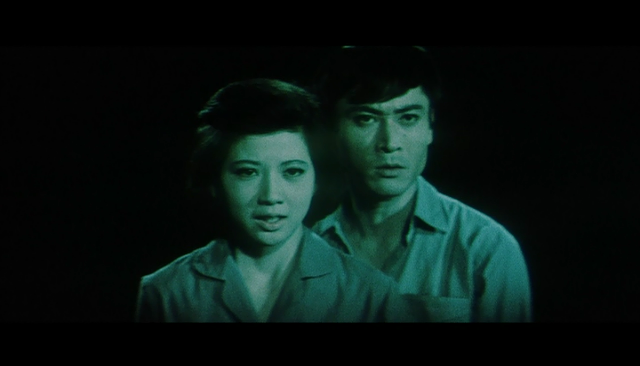
Wait, what?
Shiro also gets disturbed by this, and she goes on to say that Shiro is also the son of Sachiko's father, and had never told them. Both of Shiro's fathers appear and the Director Father starts trying to throttle Shiro's mother now. Sachiko's father begins to cry that he would have lived his life differently had he known, and as they all collapse in tears, Tamura appears, laughing. He says he's having fun manipulating them, but Sachiko begs her newfound brother to go help Harumi instead of listen to him, because she believes Tamura is a demon. Good call.
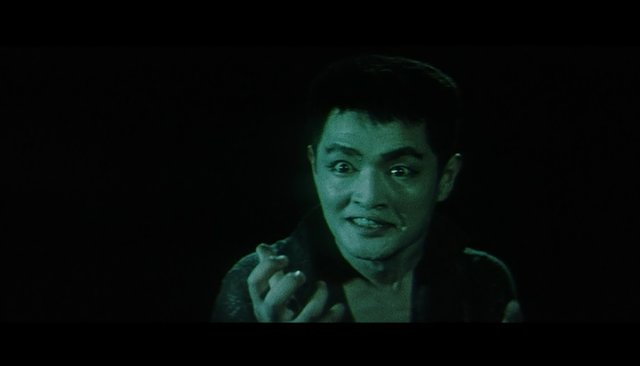
Tamura runs off laughing like a madman, but not before he is discovered by Enma Dai-Oh. For purposefully allowing himself to become evil, Tamura is sentenced to the endless torment of all Hell. He calls for Shiro's help while being tormented, but Shiro runs through areas of arms and legs buried in the ground, as well as people's faces sticking up or running around aimlessly in a large circle. An interesting fact, while much of this movie's visuals are stunning or disturbing, the budget quickly dwindled when it came to filming such a grand scale of things, and while Nakagawa was accustomed to being able to have entire areas built for his sets, they were forced to make do with nothing at this point, and the extras were tasked with digging their own holes since no more workers could be employed for the job.
Trapped in this endless throng of sinners, Shiro pushes his way through to Harumi, who is trapped on an enormous spinning wheel. This wheel, called the Wheel of Law, (Horin), represented in the West as the Wheel of Fate and Fortune and here as the Wheel of the Law of Buddha's teachings for enlightenment. It is here that Shiro finds Harumi, and Enma Dai-Oh tells him that this is his last chance to save her from eternal torment. Tamura continues screaming in agony, before falling silent. It seems that he disappears and is replaced by Shiro alone, who continues to try to reach Harumi. Everyone cries out for one another, but they are silenced.
In a beautifully horrible scene, the clock, still stuck at nine in the human world, reveals that Sachiko's father has set fire to his Hell paintings and hung himself.
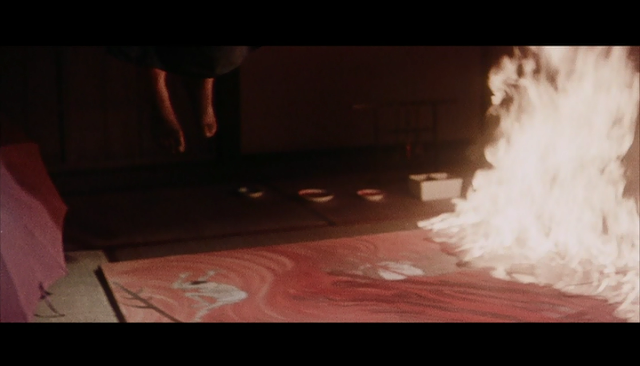
The finale of the film is filled with so much stunning imagery, the most important of which is the appearance of Yukiko and Sachiko together holding their umbrellas as they are caught under a rain of lotus petals, the symbol of purity and rebirth. So does Shiro reach Harumi? What happens to him and the rest of the characters here?
While I've tried my best to explain the symbols and plot of this film, I cannot even begin to tell you about the amazing visuals (which, for a movie from 1960 with no budget at all still hold up today), and the meaning of this film will be something different to everyone. With that, I hope that you can find this film and watch it yourself, because it is truly worth it and something not to be missed. I hope you can see it and at least enjoyed my review. I had a lot of fun writing it and seeing this film again, and I think it is something that should be shared with everybody.
Also, tomorrow is my birthday! I will try to update again soon. Thanks for reading!
No comments:
Post a Comment